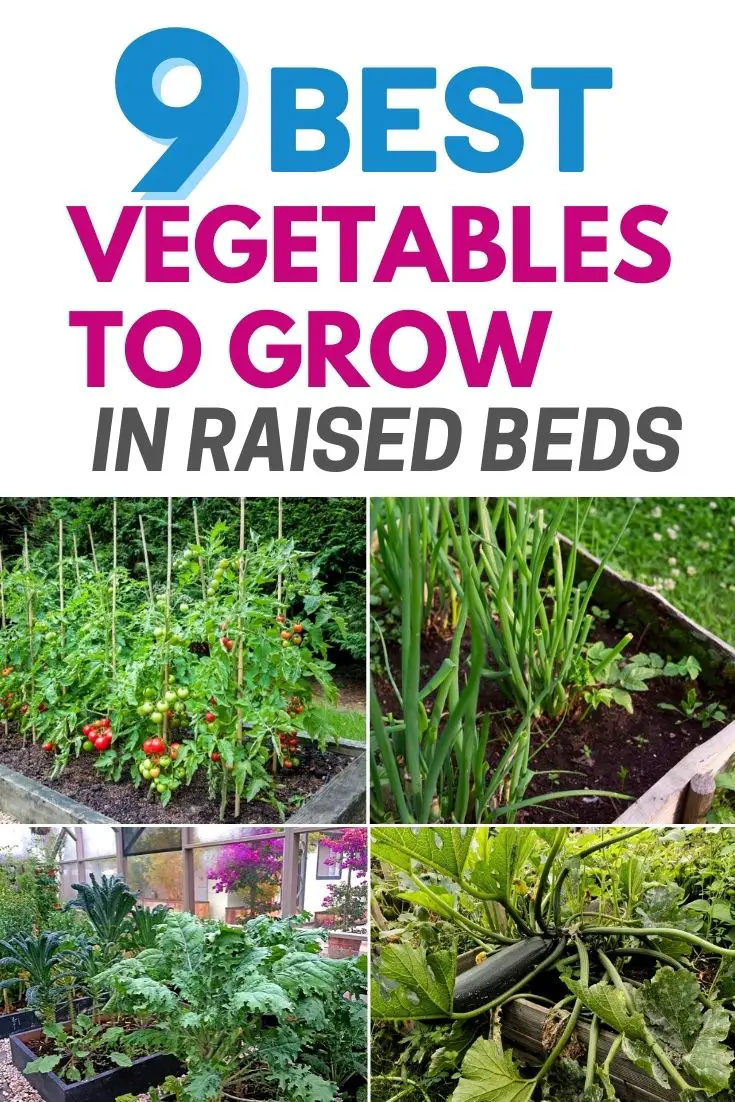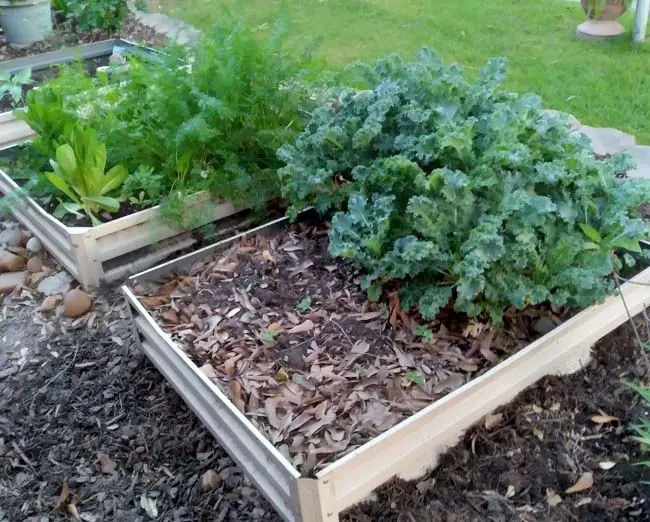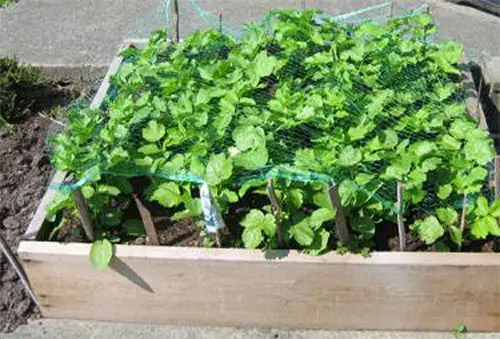Growing vegetables in raised beds have become a popular and easy way to produce vegetables in your own backyard. You can fill raised beds with everything from herbs and tomatoes to lettuce and cucumbers. Vegetables, in particular, are easy to grow, do not need much maintenance, and can save you a ton of money on your grocery bill.
You do not have to be a seasoned gardener to start a vegetable garden in a raised bed. Even someone without a “green thumb” can grow just about any type of vegetable in a raised bed, and there are some vegetables that flourish over others in this type of environment. The list below will discuss the nine best vegetables to grow in raised beds.
The Best Vegetables to Grow in Raised Beds
First and foremost, you should only fill your raised garden bed with vegetables that you and your family are going to eat. Do not start growing tons of cherry tomatoes if there is not anyone who will be eating them – you will have a ton of leftover tomatoes to throw away. You can also try something new, but only if you think someone will like it.
The goal of your raised bed is to try to grow as many vegetables as you can without squeezing in too many plants that will overrun the small area. It would help to consider how different vegetables grow – some grow horizontally, some grow under the soil, and some pop up and then become super spreaders. This will help with location.
You will need to think about when to put your raised bed together versus when to plant your vegetables. Most vegetables that thrive in raised beds can be planted right after the last frost. After that, they will more than likely flourish with a moist raised bed that promotes growth in the loose soil throughout the spring and summer months.
Raised beds also work best in areas with many suns since those are the types of veggies that work well in those smaller, confined areas. You can clear an area of weeds and grass along the side of the house or in your backyard. The easiest setup is to put together the bed then pour in a mixture of topsoil, potting soil, and compost.
9 Vegetables You Can Easily Plant and Grow
Below is a list of the nine best vegetables you can grow in a raised bed. This list is not all-encompassing – there are plenty more in which to choose – and it does not discuss the numerous kinds of herbs that also prosper in a raised garden bed. But, the examples below are everyday vegetables your family more than likely enjoys all year long.
- Tomatoes
- Leafy greens
- Root vegetables
- Zucchini and summer squash
- Cucumbers
- Potatoes
- Onions
- Beans
- Peas
There is a reason why tomatoes are the most popular garden vegetable grown in North America. They thrive in a raised bed, grow quickly, and will provide food for your family for many months. Tomatoes need nutrient-dense soil to flourish, which is easy to do in a raised bed with a controlled atmosphere where you can customize the soil you use.
you can plant tomatoes as soon as the early spring frost has passed and then will grow quickly. Cherry tomatoes, in particular, are quick-growing and start yielding results in just a few months after the seedlings are transplanted into the raised bed. Some early-maturing cherry tomatoes include:
- Jasper
- Sunrise Bumble Bee
- Sun Gold
Tomatoes do need either cages or stakes that stand in the soil for the tomatoes to grow properly. Sometimes it is hard to keep them up in the loose soil, so you should keep an eye on them daily to ensure the tomatoes do not fall over as they grow. But, the soil does not need to be too deep for the tomatoes to grow horizontally.
You can have the tomato cages or stakes in a shallow raised bed, and they will still grow beautifully. These horizontal supports also save space in your raised bed so that you can grow tomatoes next to each other. Just tie the plant to the stake with loose twine or other support to help them grow properly and harvest a delicious crop.
Leafy Greens
If tomatoes are the most popular garden vegetables, leafy greens have to be a close second. Lettuce, arugula, spinach, kale, Boston bib – the choices of leafy greens are endless, and they all perform beautifully in a raised bed. This is because leafy greens loathe soggy roots and raised beds to provide the quick-draining soil they need to flourish.
Leafy greens are cool-weather crops, so you can plant them as soon as your raised bed is made when the weather is still cold. Just sow the seeds directly into your raised bed in straight lines, around a six-inch wide band. You should also plant these seeds in an area with the full sun (where your raised bed should be anyway).
Once your leafy lettuce starts to grow, you will soon realize it really starts to grow! It will more than likely fill up much of your raised bed, which means you want to be careful of what you plant next to it. Planting root vegetables like carrots are fine since they will maintain their space underneath the soil. Small herbs also work well next to greens.
You should probably avoid planting your leafy greens next to other spreaders, like cucumbers or zucchini. You will also need to make sure you harvest your lettuce regularly, as it can get out of control. It is also recommended to harvest your leafy greens in the early morning hours for the best taste and flavor.
Root Vegetables
Since raised beds allow the soil to remain loose and crumbly because you never walk on the soil to water the vegetables, Root vegetables are the perfect choice for a raised bed. Root vegetables require well-drained and loose, rock-free soil to expand their roots throughout the soil. You know exactly what is in your raised bed in which they grew.
Raised beds are artificial, free of underground debris that may stunt the vegetables or cause them to be misshaped. Have you tried to grow carrots in a garden only to realize the stony, compacted soil caused them to come up damaged? In a raised bed, you can reassure you that your carrots and other root veggies will grow nicely:
- Carrots
- Beets
- Radish
- Parsnips
These root vegetables grow underground, so if you sow the seeds directly into the soil in the spring and keep them watered, so they are moist, these root vegetables will thrive in your raised bed. You can even sow more seeds into the raised bed every few weeks throughout the spring for harvesting root vegetables throughout the summer months.
Root vegetables can also endure the months when there may be a light frost, so you can start sowing your seeds in the very early spring months when it is still a bit chilly. That way, you start seeing the results in a few months and, by early summer, you will have yummy root vegetables in your raised garden bed. Some will grow even sooner!
For example, if you plant radishes in your raised bed, you will actually see them start appearing within just a few weeks. Then, you can continue to sow the seeds regularly from March through August for a constant supply of radishes for salads, stir fry, or for just munching on their own. Root veggies will grow abundantly throughout the summer.
Zucchini and Summer Squash
Zucchini and summer squash are super-spreaders, meaning you will always have more than you and your family can eat. They also need to be watched and harvested when they are around four to six inches long and two to three inches in diameter. If you wait, you will visit a garden filled with foot-long, huge zucchini and squash in the garden.
Raised beds are the perfect environment for the flourishing of zucchini and summer squash. These warm-season veggies cannot tolerate frost, so the extra warmth and protection a raised bed provides are perfect for keeping them healthy. The drainage, sunlight, and fertile soil of a raised bed are perfect for these super spreaders.
You should probably sow the zucchini and summer squash seeds in the corner of the raised bed. That way, they can actually grow over the bed and not take up so much room (remember, they spread wildly and can grow to monstrous sizes!). They can be seeded in the spring after the soil is warm enough and the last frost has passed.
If you want to start your zucchini and summer squash growth sooner, you can always start them indoors and then transplant them into the corner of your raised bed. There are numerous varieties of zucchini and summer squash to choose from, and they all grow the same way and are delicious. Just remember, they are greedy growers.
Cucumbers
Like zucchini and summer squash, cucumbers are hearty growers in a raised bed and can actually be seeded in the bed and then grow over the sides of the raised area. However, these need to be watched daily to make sure they do not promote rotting or disease. If that is the case, you should have them grow on something in the raised bed.
The second option can be done similar to tomatoes, using either a cage or trellis. That way, the cucumbers will flourish in the cages or on the trellis but also be free from any rotting or disease from being left on the ground outside of the raised bed. You can also make sure the cucumbers stay within the confines of the cage to save space.
Raised beds are perfect for cucumbers that need moist soil throughout the day so that the cucumbers do not taste bitter. You will want to harvest them frequently; just like zucchini and summer squash, you could turn your head for a second and have a foot-long cucumber waiting to be picked in the raised bed! They also need lots of sun.
Speaking of large cucumbers, you may think larger is better because it is more food, but that is not true. If you allow your cucumbers to grow too large, your cucumber plant may think it is done with its work and stop producing cucumbers. You may also want to grow a sunflower next to your cucumber plant, as it is said to promote sweetness.
Potatoes
Potatoes have become a popular choice for raised beds because they are a staple on tables for breakfast, lunch, and dinner and because of the way they are harvested. Potatoes grow very well in hilling soil, and in a raised bed, you can control the hills around the shoots as they grow. You can add hills to the potatoes as they produce.
What this means is, as the potato stalks grow in your raised garden, you can mound soil around the stalks (like a hill) to protect the plant and reassure that the plants grow and flourish. The looser the soil, the easier and more productive this hilling process will be for the plants. Similar to root vegetables, potatoes thrive in loose soil and spread out.
You should plant them around six inches deep into the soil, but you will soon notice they will grow closer to the soil’s surface. Therefore, you really do not need to water the plants until you see the potatoes starting to sprout. Once you see some sprouting, you will want to keep your potato buds moist to bloom properly.
Once your potato plants finish blooming in your raised bed, you can then start pulling the baby spuds from the ground. Then, when the foliage has died back, you are then ready to harvest the mature spuds. This is probably about two weeks after the baby spuds are pulled and the foliage has died back appropriately enough for harvest.
Onions
You probably use onions almost every day, so why not grow them in your very own raised bed? Onions are one of the easiest vegetables to grow under normal circumstances, and they are the near-perfect vegetable to grow in a raised bed. Although there are many benefits to growing onions, they benefit due to three things:
- Onions need a long growing season – more than 100 days to mature.
- Onions thrive in quick-draining soil that raised beds to provide.
- Onions need a lot of organic matter, which you can control in a raised bed.
Because they take so long to grow, you will want to get your onion seeds planted as soon as you can. The warmth of a raised bed will help you start their harvest earlier so that you can have onions over the next few months.
Instead of sowing seeds, you can use seedlings or plant them as sets, tiny mature onions from the prior season.
Seeds will grow the largest variety of onions, but seedlings can be purchased in bundles and then planted in the raised bed. Sets are small latent bulbs that grew from seed during the previous season and can be purchased at a typical garden center. They are planted a few inches deep and are perfect for scallions, also known as green onions.
You will want to be sure you add a sufficient amount of compost to the area where you are growing the onions. This is similar to tomatoes, which thrive with coffee grounds and eggshells. Onions also thrive from natural compost, and although it does not smell as nice as coffee, preparing the bed by turning under animal manure works well.
Beans
Whether you like green beans, French beans, pole, or bush beans, they are nearly foolproof when it comes to harvesting them in a raised bed. You need to throw the seeds in a line, then sow them around two inches apart in rows, and then wait only a few months after seeding for the full harvest to approach and be ready for picking.
The two types of green beans that work really well are bush and pole beans. They are deficient maintenance and only need to be sowed around one inch deep. Once they start growing, you can trip them back while you are picking the beans for consumption. They are quick to germinate to grow in your raised bed but do not do well transplanted.
- Bush beans grow fast, only a few months to harvest, and are easy to plant and raise anywhere from one foot to two feet tall. They last for around three weeks.
- Pole beans – These grow about eight to ten feet tall as vines, so they need to grow up a trellis or some netting. Their harvest lasts longer than bush beans, around six to eight weeks long.
As noted above, bush beans need much less space since they grow just a few feet, while pole beans require much more space and require a trellis for support and the ability for the vines to climb. Pole beans also take about a week or two longer to harvest than bush beans, but pole beans will produce much more beans in the end.
Peas
Peas literally taste like spring, so why not grow them during the spring and summer months in your raised bed? They are one of the easiest vegetables to grow and come in various delicious choices: snow peas, shell peas, and sugar snap, to name a few. You can sow them in early spring, about a month before the last expected frost.
You will want to sow the seeds one to two inches apart in two rows spaced six inches apart. Then, you keep them moist and wait for their deliciousness to harvest. If you sow the seeds in March because they are fine in cool soil, you will harvest them by the end of June. They are delicious, easy, and abundant.
Did you find this post useful? Would you like to get back to it later? Save THIS PIN below to your garden-raised beds and vegetable garden boards on Pinterest! Thanks 🙂



